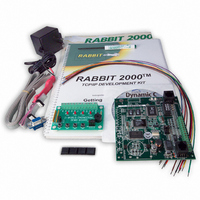101-0401 Rabbit Semiconductor, 101-0401 Datasheet - Page 31

101-0401
Manufacturer Part Number
101-0401
Description
KIT DEV RABBIT2000/TCP/IP
Manufacturer
Rabbit Semiconductor
Series
RabbitCore 2000r
Type
MPU Moduler
Datasheet
1.101-0402.pdf
(82 pages)
Specifications of 101-0401
Rohs Status
RoHS non-compliant
Contents
Rabbit 2000™ TCP/IP Development Board, Demo Board, Power Supply, Cable and Software
Processor To Be Evaluated
Rabbit 2000
Interface Type
RS-232, RS-485
For Use With/related Products
RCM2000, RCM2010, RCM2020
Lead Free Status / Rohs Status
Lead free / RoHS Compliant
Other names
101-0401
316-1005
Q906133
316-1005
Q906133
the first time, the current value of
is saved and then on each subsequent pass
MS_TIMER
the saved value is compared to the current value. If a
condition is not encoun-
waitfor
tered, then a jump is made to the end of the costatement (4), and on the next pass of the
loop, when the execution thread reaches the beginning of the costatement, execution
passes directly to the
statement. Once 200 ms has passed, the statement after the
waitfor
waitfor is executed. The costatement has the property that it can wait for long periods of
time, but not use a lot of execution time. Each costatement is a little program with its own
statement pointer that advances in response to conditions. On each pass through the big
loop, as little as one statement in the costatement is executed, starting at the current posi-
tion of the costatement’s statement pointer. Consult the Dynamic C User’s Manual for
more details.
The second costatement in the program debounces the switch and maintains the variable
. Debouncing is performed by making sure that the switch is either on or off for a
vswitch
long enough period of time to ensure that high-frequency electrical hash generated when
the switch contacts open or close does not affect the state of the switch. The
state-
abort
ment is illustrated at (5). If executed, the internal statement pointer is set back to the first
statement within the costatement.
At (6) a use for a shadow register is illustrated. A shadow register is used to keep track of
the contents of an I/O port that is write only - it can’t be read back. If every time a write is
made to the port the same bits are set in the shadow register, then the shadow register has
the same data as the port register. In this case a test is made to see the state of the LED and
make it agree with the state of vswitch. This test is not strictly necessary, the output regis-
ter could be set every time to agree with vswitch, but it is placed here to illustrate the con-
cept of a shadow register.
To illustrate the use of snooping, use the watch window to observe
while the
vswitch
program is running. Add the variable
to the list of watch expressions. Then tog-
vswitch
gle
and the LED. Then type
to observe
again.
<Ctrl-U>
vswitch
vswitch
3.7.4 Advantages of Cooperative Multitasking
Cooperative multitasking, as implemented with language extensions, has the advantage of
being intuitive. Unlike preemptive multitasking, variables can be shared between different
tasks without having to take elaborate precautions. Sharing variables between tasks is the
greatest cause of bugs in programs that use preemptive multitasking. It might seem that
the biggest problem would be response time because of the big loop time becoming long
as the program grows. Our solution for that is a device caused slicing that is further
described in the Dynamic C User’s Manual.
Getting Started
27













